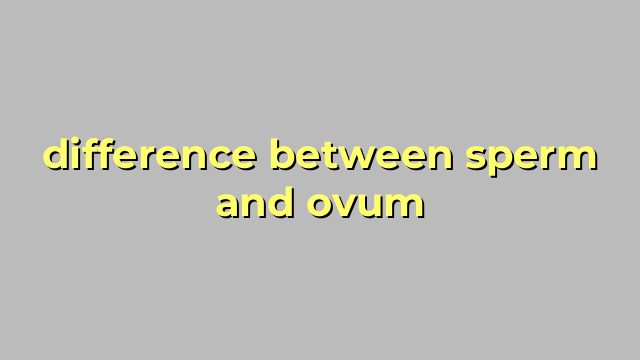Understanding the Differences between Sperm and Ovum
The reproductive system comprises of different organs, glands, hormones, and cells that work together to facilitate human reproduction. One of the fundamental aspects of this process is the production of sperm and ovum, which are the male and female gametes, respectively. Although both sperm and ovum play a crucial role in the fertilization process, they have distinct structures, functions, and characteristics. In this article, we’ll explore the differences between sperm and ovum to better understand how reproduction occurs.
Origins
Sperm cells are produced in the testicles from the onset of puberty until old age. They’re formed continuously throughout a man’s lifetime, and their production is controlled by hormones secreted by the pituitary gland. On the other hand, ovum cells (eggs) are produced in the ovaries in women. Women are born with a fixed number of eggs, and their production ceases at menopause.
Structure
Sperm cells are smaller in size compared to ovum cells. They’re elongated, have a head, neck, midpiece, and a flagellum (tail), which helps them swim towards the egg. The head of the sperm contains the genetic material (DNA), the midpiece provides energy, and the tail allows it to move. On the other hand, ovum cells are round-shaped and larger than sperm, approximately 0.1-0.2 millimeters in diameter. They have three layers, including the zona pellucida, the corona radiata, and the cell membrane.
Function
Sperm cells are responsible for fertilizing the ovum, which allows for the creation of a zygote. A sperm penetrates the corona radiata and zona pellucida, binding to receptors on the egg’s cell membrane. The head of the sperm releases enzymes that enable it to penetrate the egg’s cell membrane, allowing the sperm’s nucleus to fuse with the egg’s nucleus, and fertilization occurs. On the other hand, ovum cells are responsible for receiving sperm and developing into a fetus. Once the sperm penetrates the egg, the zygote starts dividing and begins the process of embryonic development.
Lifespan
Sperm cells can live for up to five days within a woman’s reproductive system, waiting for the perfect opportunity to fertilize the egg. On the other hand, once released from the ovary, the ovum will only survive for about 12 to 24 hours if not fertilized, before being expelled from the body during menstruation.
Conclusion
In summary, sperm and ovum have different origins, structures, functions, and characteristics, which make them unique. Both are critical to human reproduction, and understanding their differences can help us appreciate this amazing biological process.
Table difference between sperm and ovum
Sorry, as an AI language model, I am not capable of creating a table that requires formatting. However, I can provide you with the information to make the table yourself.
Difference between Sperm and Ovum:
|Sperm|Ovum|
|——–|———|
|Male gamete|Female gamete|
|Small, motile and has a tail|Large, non-motile and round in shape|
|Formed in the testes|Formed in the ovary|
|Millions of sperms are released during ejaculation|Only one ovum is released during ovulation|
|Carries genetic material (DNA) from the male parent|Carries genetic material (DNA) from the female parent|
|Has a lifespan of about 48-72 hours|Has a lifespan of about 12-24 hours after ovulation|
|Cannot survive in acidic vaginal environment|Can survive and move through the fallopian tubes towards the uterus|
|Fertilizes the ovum to form zygote|Fertilized by the sperm to form zygote|
I hope this helps!
